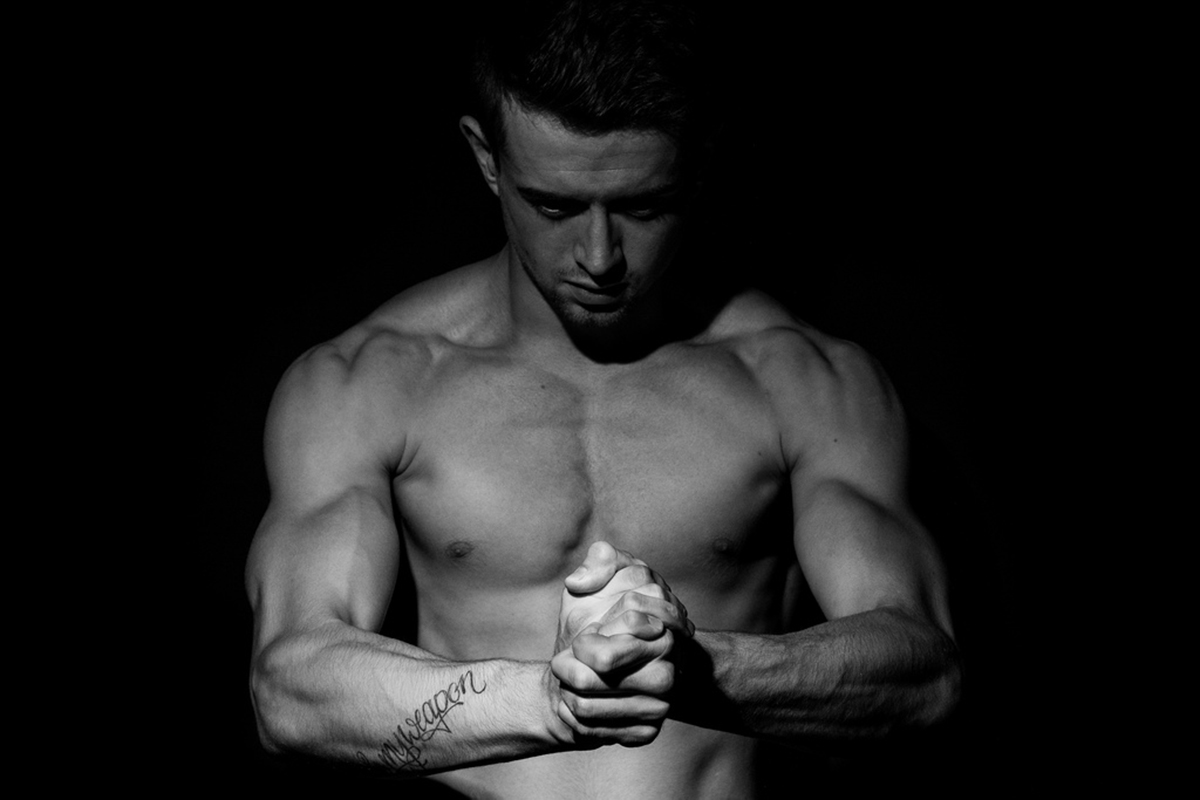On magazines, on posters, in movies, the female "ideal" has notoriously become unattainable for the majority of women. Unless you're disproportionately tall and slender, have the breasts of a woman three dress sizes up from you, and are happy to spend the whole of your life ten pounds underweight, most women simply can't look the way we're told they should - and they probably should't want to. But just as the feminine ideal has moved from Marilyn Monroe to Callista Flockhart, so the masculine ideal has also become, not just unattainable, but literally impossible.

Unlike many apes, humans don't have much physical dimorphism (two shapes) between the sexes. Men are generally a bit bigger, a bit heaver and have a little more muscular definition. Women have broader hips, are generally a bit shorter and lighter and have less visible muscular definition. But really, that's it: we're talking about a few inches and a few pounds. As of the 1999-2002 United States National Health and Nutrition Examination Survey, the average man was 4% taller and 8% heavier than the average woman - a difference of about 14 pounds if the man weighs 170lb.
Looking at Hollywood, though, you'd never know it. On the silver screen, women are tiny and men are huge. In his Batman films, Christian Bale weighed around 220lb. When Angeline Jolie made an action film, she weighed about 125 pounds. That's a pretty big difference - Jolie weighed about half what Bale weighed. That's a difference between men and women on the silver screen that's seven times bigger than it is in real life.
Of course, both these actors are noticeably taller than the average. Since there's not much we can do about our height, though, women feel under pressure to both have curves and be very slim, but men are increasingly under a corresponding pressure to be both very muscular and very lean. "A decade or so ago, Stallone and Van Damme and Schwarzenegger were the action stars," said Deborah Snyder, who produces her husband Zack Snyder's films: 300, Man of Steel, the upcoming Batman vs. Superman movie. Speaking to Men's Journal, Ms. Snyder went on: "Now we expect actors who aren't action stars to transform themselves. And we expect them to be big and powerful and commanding."
See Also: The Secret To Building Muscle: Less Myostatin Equals More Muscle Mass
A physique that would be unusual in a professional athlete is thus presented as the average, everyday norm.
While for women that means a body that would make a ballerina's friends spring for an intervention pizza, for men it means a degree of muscularity and leanness that's not just unrealistic - it's unreal. It's not just unattainable for most people: it's literally impossible.
Even The Guys Who Look Like That Don't Really Look Like That
Where we see male actors in action films they're literally impossibly built. Leaving aside the assumption, common in many circles but unproveable, that a lot of these people are using steroids (once restricted to athletes), there's a lot of acknowledged trickery going on behind the camera.

Think of Hugh Jackman in the Wolverine films. Hugh Jackman really does look pretty good. He trains year-round and does sensible things to keep in the kind of shape you'd be in if multi-million dollar pay checks depended on your appearance. But he doesn't look like Wolverine year-round.
That's accepted, we all know it if we think on it for a moment.
But the reality is he doesn't look like Wolverine all week, even when the films are being shot.
That's because the requirements for action stars' appearances have changed. "In the Eighties, it was the bigger, the better," says director Tim Burton. "Think of that shot from Rambo of Sly holding the machine gun and the veins in his forearms bulging." Now, though, the game is to get actors to the kind of low single figure body fat that was previously only seen on boxers who'd unwisely cut weight right before the weigh-in with aggressive dieting and dehydration, and competitive bodybuilders on podium day who utilized the same potentially dangerous techniques.
Many refer to the big game changer as being 1999's "Fight Club." Leading man Brad Pitt had until then been a star with major girl appeal but who was regarded as being too effeminate for action stardom or male icon status. Reborn as the aggressive, self-directed and violent Tyler Durden he was instrumental in reinventing the action hero physique. "Everyone thought he was huge, but he was, like, 155 pounds," says Mark Twight, who trained the cast for famously bulging "300". "If you strip away fat and get guys to 3, 4 percent body fat, they look huge without necessarily being huge."
Thing is, keeping super-low body fat for months while you shoot a movie isn't really possible.
Your body fat is there for a reason. If you're an adult man and you get your body fat into single figures, the odds are that after a few days you're going to start experiencing a range of unpleasant symptoms like dizziness, fatigue, weakness, cognitive failure, and even organ failure; your adrenal glands can start to malfunction and your heart, kidneys, liver and lungs can all be affected. That's not the ideal condition in which to be play fighting for millions of dollars.
Other workarounds include exercising directly before shooting. Exercising pushes blood to the muscles, making them look larger. So before shooting action scenes in 'Snatch,' Brad Pitt was notorious for dropping to the floor and knocking out 25 pushups.
See Also: Plyometric Training Benefits For Team Sport Players
Phillip Winchester, who plays Michael Stonebridge in the Cinemax series 'Strike Back,' remembers seeing this and asking himself, '"why is he showing off?" I'd always wondered, "How do actors look so jacked all the time?" Well, they don't. Now, we ask: "Is it a pushup scene?" When I shot that strike back poster, I was doing pushups like a madman, saying, "take the picture now! Take it now!"'
If you think I've hit the nail on the head, or there's something in this article you want to talk about, why not get in touch in the comments section below?
- Photo courtesy of liam_somerville via Flickr: www.flickr.com/photos/techtronic/9878426735
- Photo courtesy of Meester X via Flickr: www.flickr.com/photos/69263780@N04/8307433014

